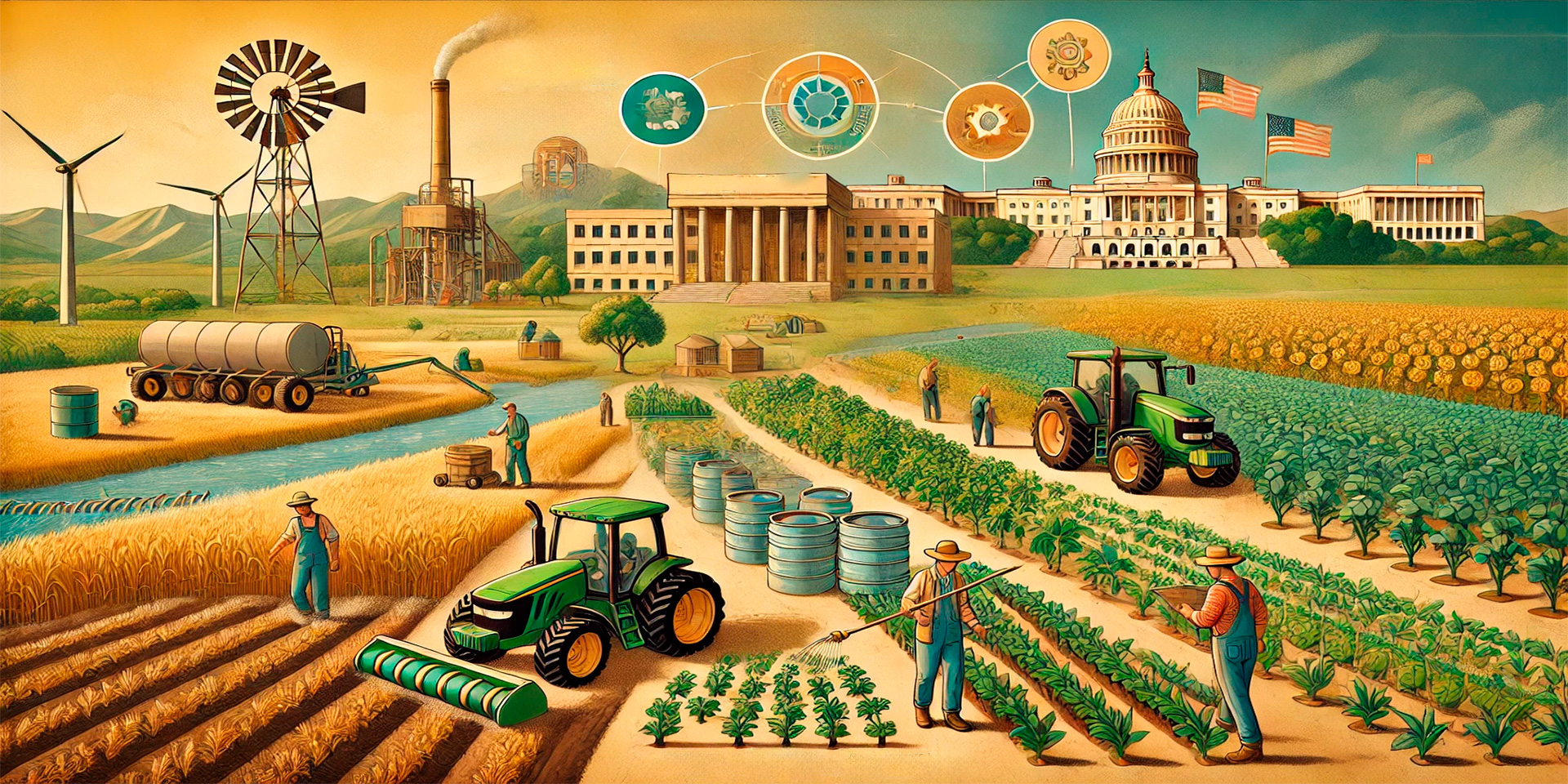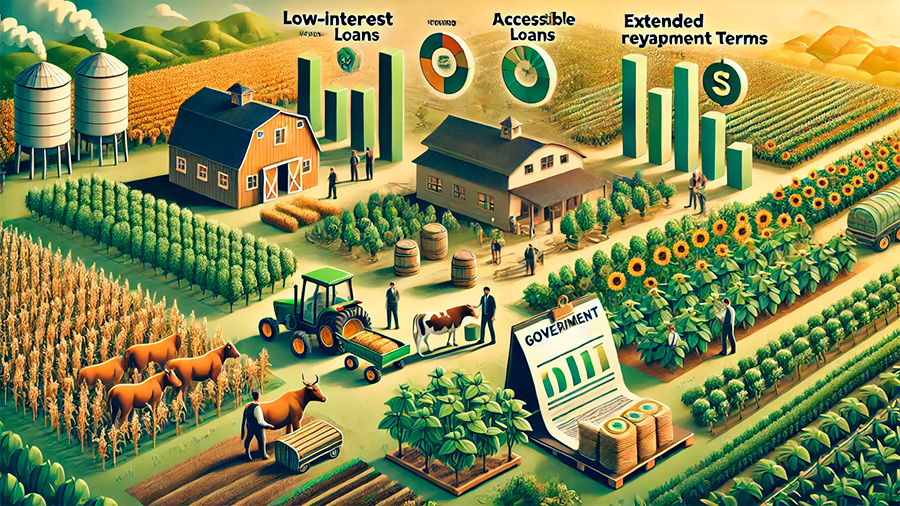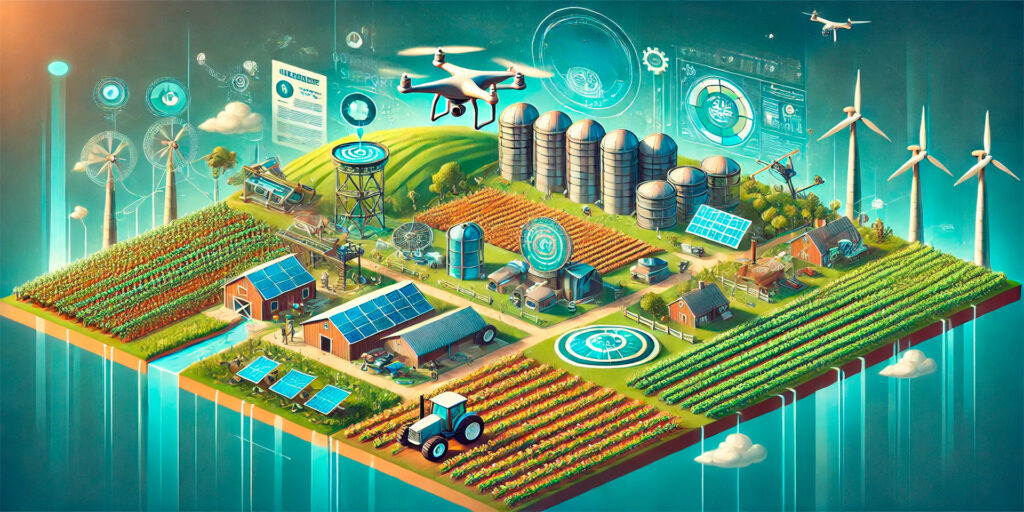Strengthening Agriculture Through Strategic Lending: The Role of Government Loans

Farming is an inherently risky business, with challenges ranging from crop infections and equipment breakdowns to the unpredictability of climate change. These risks can lead to significant financial losses for farmers, making it difficult to sustain operations and invest in future growth. However, government loan programs are playing an increasingly important role in helping farmers mitigate these risks, providing the financial support needed to manage uncertainties and build more resilient agricultural enterprises.
This article explores how government lending programs are supporting farmers in reducing agricultural risks by offering loans that cover everything from infection control and equipment upgrades to climate adaptation strategies.
Understanding Agricultural Risks
Agriculture faces a wide variety of risks that can impact both productivity and profitability. These risks can stem from natural causes, such as extreme weather events and plant diseases, or mechanical failures, like equipment breakdowns during critical planting or harvest seasons. In recent years, climate change has added another layer of complexity, as unpredictable weather patterns increase the volatility of crop yields.
Without adequate financial support, farmers may struggle to recover from these risks, leading to significant economic strain. Government loans are designed to provide relief, offering farmers the capital they need to address these challenges head-on.
1. Climate-Related Risks
Climate change poses one of the most significant risks to modern agriculture. Extreme weather events, such as droughts, floods, and heatwaves, can devastate crops, reduce yields, and disrupt planting and harvesting schedules. Additionally, shifting weather patterns can lead to unpredictable growing seasons, making it difficult for farmers to plan ahead.
How government loans help mitigate climate risks:
- Financing climate-resilient infrastructure: Loans can help farmers invest in irrigation systems, drainage solutions, and weather-resistant storage facilities to protect crops from extreme weather.
- Supporting crop diversification: Loans can provide the capital needed to diversify crops, reducing dependence on a single crop that may be more vulnerable to climate-related issues.
2. Crop Infections and Pest Management
Pests, diseases, and infections can wreak havoc on crops, leading to lower yields and higher costs for farmers. Outbreaks of plant infections, such as bacterial or fungal diseases, can spread rapidly, affecting entire fields and even regions. The cost of managing these infections through treatments, pesticides, or crop replacement can be prohibitive for many farmers without access to financial support.
How government loans support infection management:
- Funding for infection control technologies: Government loans can help farmers invest in advanced pest control technologies, such as biological pest management systems or disease-resistant seeds.
- Covering the cost of treatment: Loans provide farmers with the capital needed to purchase pesticides, fungicides, or other treatment options to contain and eliminate infections.
3. Equipment Breakdowns and Modernization
Agricultural equipment, such as tractors, plows, and irrigation systems, is essential for modern farming operations. However, equipment breakdowns can disrupt farming schedules, reduce productivity, and lead to costly repairs or replacements. Without reliable machinery, farmers may struggle to maintain their operations efficiently.
Additionally, outdated equipment can hinder productivity and limit a farm’s ability to adopt more sustainable practices. Government loans offer a solution by helping farmers finance the repair, replacement, or upgrading of equipment to ensure smooth and efficient operations.
How government loans support equipment upgrades:
- Financing equipment repairs: Loans provide the capital needed to repair broken machinery, minimizing downtime and keeping farms operational during critical periods.
- Upgrading to modern, efficient technology: Government loans can be used to invest in advanced machinery that improves efficiency, reduces labor costs, and supports sustainable farming practices.

The Role of Government Lending Programs
Government lending programs are specifically designed to help farmers mitigate the risks they face by providing accessible and affordable financing options. These programs often come with favorable terms, such as low-interest rates, extended repayment periods, and flexible eligibility requirements, making them more accessible than traditional bank loans.
By offering targeted loans for agriculture, governments aim to support the long-term sustainability and profitability of farming operations, ensuring that farmers have the financial tools they need to weather challenges and invest in future growth.
1. USDA Farm Service Agency (FSA) Loans
In the United States, the Farm Service Agency (FSA) provides a range of loan programs aimed at supporting farmers and ranchers, particularly those who may have difficulty accessing traditional loans. These loans cover everything from farm ownership to operating expenses and equipment purchases, making them a versatile tool for mitigating various agricultural risks.
Examples of FSA loan programs:
- Farm Operating Loans: These loans can be used to cover day-to-day operating expenses, such as equipment repairs, livestock feed, and inputs for crop production.
- Farm Ownership Loans: These loans help farmers purchase or expand farmland, build essential infrastructure, or make improvements to existing properties.
2. Emergency Disaster Loans
When natural disasters strike, farmers often face immediate and severe financial challenges. Crops may be destroyed, livestock lost, and equipment damaged beyond repair. To help farmers recover from these disasters, many governments offer emergency disaster loans that provide immediate financial relief. These loans typically have favorable terms and are designed to help farmers rebuild their operations after a disaster.
How emergency disaster loans support recovery:
- Rebuilding damaged infrastructure: Loans help cover the costs of repairing or rebuilding farm buildings, fences, irrigation systems, and other critical infrastructure damaged by disasters.
- Replacing lost crops and livestock: Farmers can use disaster loans to purchase new seeds, replace livestock, and restore their farms to pre-disaster levels of production.
3. Climate Adaptation and Sustainability Loans
Many governments are recognizing the growing impact of climate change on agriculture and are developing lending programs specifically aimed at helping farmers adapt to these changes. These loans often focus on promoting sustainability and resilience by funding projects that improve water management, soil health, and energy efficiency on farms.
Examples of climate-focused lending programs:
- Water conservation loans: Loans can be used to invest in more efficient irrigation systems, such as drip irrigation, that reduce water usage while maintaining crop yields.
- Renewable energy loans: Farmers can access loans to invest in renewable energy sources, such as solar panels or wind turbines, to reduce their environmental footprint and cut energy costs.

Benefits of Government Loans for Farmers
Government loans offer several advantages that make them an attractive option for farmers looking to manage risk and invest in the future. These benefits include lower interest rates, longer repayment terms, and access to capital that may not be available through traditional financial institutions. In many cases, government loans are designed specifically for the agricultural sector, ensuring that the unique needs of farmers are addressed.
1. Lower Interest Rates and Favorable Terms
Government loans typically come with lower interest rates than private loans, making them more affordable for farmers. Additionally, the repayment terms are often more flexible, allowing farmers to repay the loans over a longer period of time. This is especially important in agriculture, where income can be seasonal and unpredictable.
Benefits of lower interest rates:
- Reduced financial burden: Lower interest rates make it easier for farmers to manage debt while maintaining cash flow for other essential operations.
- Flexible repayment terms: Longer repayment periods provide farmers with the time needed to generate income and repay loans without undue pressure.
2. Access to Capital for Growth and Innovation
Government loans are an important source of capital for farmers who want to invest in new technologies, infrastructure, or sustainable practices. These loans make it possible for farmers to adopt innovative solutions that improve productivity, reduce risk, and ensure long-term profitability.
How government loans support growth:
- Investing in new technologies: Farmers can use loans to purchase advanced equipment, such as GPS-guided tractors, drones, or automated irrigation systems, that improve efficiency and reduce costs.
- Supporting sustainable practices: Loans can fund the transition to organic farming, regenerative agriculture, or other sustainable methods that enhance soil health and biodiversity.
Conclusion
Government loans play a crucial role in helping farmers manage the many risks associated with agriculture, from climate change and equipment breakdowns to crop infections and pest management. By providing accessible financing options with favorable terms, these loans offer farmers the financial support they need to mitigate risks, invest in new technologies, and build more resilient farming operations. As agriculture continues to face new challenges, government lending programs will remain a critical tool in ensuring the sustainability and success of the industry.

